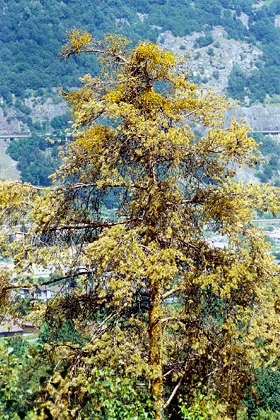Duration: 2013-2015
Contact: Matthias Saurer,
Contact: Matthias Saurer,
Background
This project is part of the COST Action FP 1106 "STREESS - STUDYING TREE RESPONSES TO EXTREME EVENTS: A SYNTHESIS". We aim to answer the following central question: Do trees with differing intrinsic water-use efficiency differ in the likelihood that they will survive severe drought stress? Due to the global CO2 increase and concurrent climate change, many forest ecosystems are recently subject to increasing drought. In the dry inner-Alpine Rhone valley (Switzerland), for instance, recent die-back of Scots pine is suspected to be related to increasing drought. The mechanisms underlying tree mortality are, however, not yet well understood. The question why some trees from a particular site may cope better with water stress than other trees from the same location (thus subject to the same environmental factors) is largely unresolved. Here, the use of stable isotopes of carbon and oxygen is a very powerful method. The carbon isotope ratio of organic matter in plants reflects the balance between photosynthetic carbon uptake and water loss through the stomatal pores, and thus it is correlated to the intrinsic water-use efficiency (iWUE). Trees differ in their iWUE due to environmental conditions, but also due to endogenous (e.g. genetic) factors. Based on measurements of the carbon isotope ratio in tree rings it can therefore be tested whether trees with relatively high iWUE are able to cope better with drought periods. Oxygen isotope analysis of the same plants provides additional information about changes in stomatal conductance, based on a dual isotope approach.
Main goals
We propose to conduct 3 experiments. 1) We will use a large-scale irrigation experiment in a mature pine forest in the Swiss Rhone valley for screening the relationship between carbon isotope ratios and growth responses of Scots pine (Pinus sylvestris L.) to drought under natural and irrigated conditions on a large number of individual trees (N>100). 2) We will study species-specific responses to drought in a nearby site where several native and non-native species are co-occurring, including Scots pine and the more drought resistant pubescent oak (Quercus pubescens) as well as the non-native Pinus nigra and Pseudotsuga menziesii 3) We will complement the field studies with a laboratory experiment where small oak and pine plants will be subjected to drought and the relevant isotope fractionation and carbon allocation processes will be studied in detail using compound-specific isotope analysis (isotope analysis of individual sugars and starch). This will enable us to identify more precisely the links between drought effects, the carbon balance and water-use efficiency.
The study will provide new insights into the trees’ response to drought and help policy makers to obtain necessary information for forest management. Our goal is to provide a prognostic tool based on a carbon isotope screening and growth analysis to estimate which trees may most likely survive future drought periods and which ones will die. The proposal was submitted within the COST Action FP 1106 “STREeSS – Studying tree responses to extreme events: A synthesis” and is funded by the the Swiss State Secretariat for Education, Research and Innovation. The project will be carried out in close cooperation with WSL Birmensdorf.
The study will provide new insights into the trees’ response to drought and help policy makers to obtain necessary information for forest management. Our goal is to provide a prognostic tool based on a carbon isotope screening and growth analysis to estimate which trees may most likely survive future drought periods and which ones will die. The proposal was submitted within the COST Action FP 1106 “STREeSS – Studying tree responses to extreme events: A synthesis” and is funded by the the Swiss State Secretariat for Education, Research and Innovation. The project will be carried out in close cooperation with WSL Birmensdorf.


